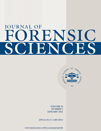An STR Melt Curve Genotyping Assay for Forensic Analysis Employing an Intercalating Dye Probe FRET*
Portions of this work were supported by Award No. 2008-DN-BX-K012 awarded by the National Institute of Justice, Office of Justice Programs, U.S. Department of Justice. The opinions, findings, and conclusions or recommendations expressed in this publication are those of the authors and do not necessarily reflect those of the Department of Justice. Patent Application submitted November, 2008—Patent pending.
Abstract
Abstract: The most common markers used in forensic genetics are short tandem repeats (STRs), the alleles of which are separated and analyzed by length using capillary electrophoresis (CE). In this work, proof of concept of a unique STR genotyping approach has been demonstrated using asymmetric PCR and a fluorescence resonance energy transfer (FRET)-based hybridization analysis that combines fluorophore-labeled allele-specific probes and a DNA intercalating dye (dpFRET) in a melt match/mismatch analysis format. The system was successfully tested against both a simple (TPOX) and a complex (D3S1358) loci, demonstrated a preliminary detection limit of <10 genomic equivalents with no allelic dropout and mixture identification in both laboratory-generated and clinical samples. With additional development, this approach has the potential to contribute to advancing the use of STR loci for forensic applications and related fields.




